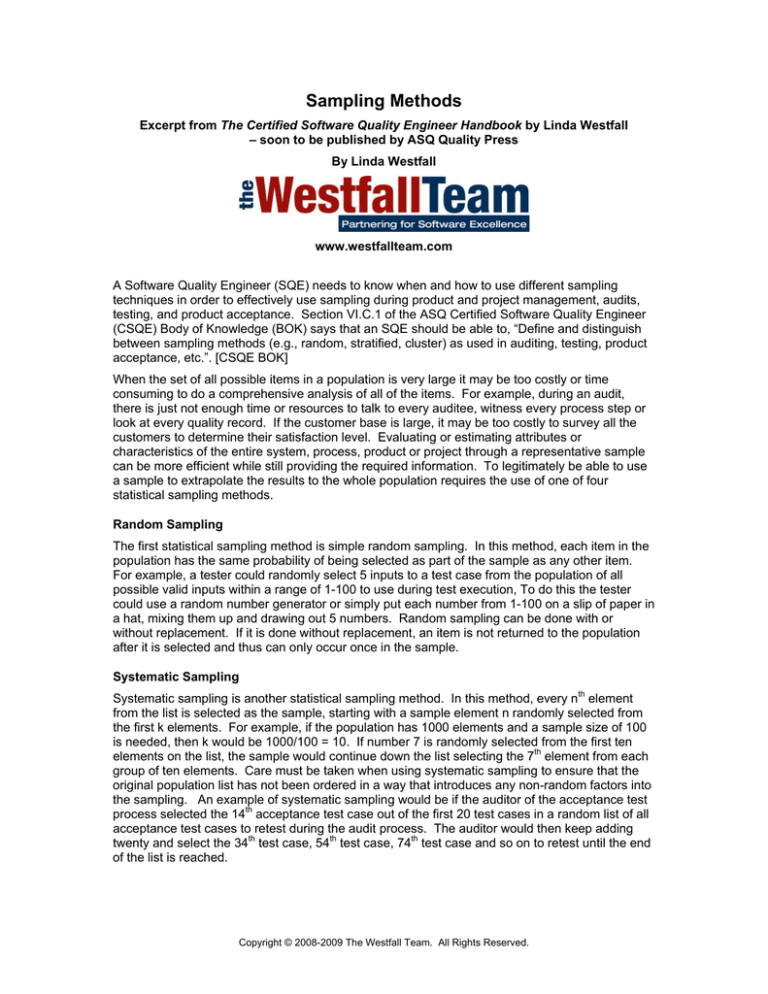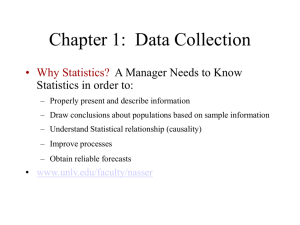
Sampling Methods
Excerpt from The Certified Software Quality Engineer Handbook by Linda Westfall
– soon to be published by ASQ Quality Press
By Linda Westfall
www.westfallteam.com
A Software Quality Engineer (SQE) needs to know when and how to use different sampling
techniques in order to effectively use sampling during product and project management, audits,
testing, and product acceptance. Section VI.C.1 of the ASQ Certified Software Quality Engineer
(CSQE) Body of Knowledge (BOK) says that an SQE should be able to, “Define and distinguish
between sampling methods (e.g., random, stratified, cluster) as used in auditing, testing, product
acceptance, etc.”. [CSQE BOK]
When the set of all possible items in a population is very large it may be too costly or time
consuming to do a comprehensive analysis of all of the items. For example, during an audit,
there is just not enough time or resources to talk to every auditee, witness every process step or
look at every quality record. If the customer base is large, it may be too costly to survey all the
customers to determine their satisfaction level. Evaluating or estimating attributes or
characteristics of the entire system, process, product or project through a representative sample
can be more efficient while still providing the required information. To legitimately be able to use
a sample to extrapolate the results to the whole population requires the use of one of four
statistical sampling methods.
Random Sampling
The first statistical sampling method is simple random sampling. In this method, each item in the
population has the same probability of being selected as part of the sample as any other item.
For example, a tester could randomly select 5 inputs to a test case from the population of all
possible valid inputs within a range of 1-100 to use during test execution, To do this the tester
could use a random number generator or simply put each number from 1-100 on a slip of paper in
a hat, mixing them up and drawing out 5 numbers. Random sampling can be done with or
without replacement. If it is done without replacement, an item is not returned to the population
after it is selected and thus can only occur once in the sample.
Systematic Sampling
Systematic sampling is another statistical sampling method. In this method, every nth element
from the list is selected as the sample, starting with a sample element n randomly selected from
the first k elements. For example, if the population has 1000 elements and a sample size of 100
is needed, then k would be 1000/100 = 10. If number 7 is randomly selected from the first ten
elements on the list, the sample would continue down the list selecting the 7th element from each
group of ten elements. Care must be taken when using systematic sampling to ensure that the
original population list has not been ordered in a way that introduces any non-random factors into
the sampling. An example of systematic sampling would be if the auditor of the acceptance test
process selected the 14th acceptance test case out of the first 20 test cases in a random list of all
acceptance test cases to retest during the audit process. The auditor would then keep adding
twenty and select the 34th test case, 54th test case, 74th test case and so on to retest until the end
of the list is reached.
Copyright © 2008-2009 The Westfall Team. All Rights Reserved.
Stratified Sampling
The statistical sampling method called stratified sampling is used when representatives from each
subgroup within the population need to be represented in the sample. The first step in stratified
sampling is to divide the population into subgroups (strata) based on mutually exclusive criteria.
Random or systematic samples are then taken from each subgroup. The sampling fraction for
each subgroup may be taken in the same proportion as the subgroup has in the population. For
example, if the person conducting a customer satisfaction survey selected random customers
from each customer type in proportion to the number of customers of that type in the population.
For example, if 40 samples are to be selected, and 10% of the customers are managers, 60% are
users, 25% are operators and 5% are database administrators then 4 managers, 24 uses, 10
operators and 2 administrators would be randomly selected. Stratified sampling can also sample
an equal number of items from each subgroup. For example, a development lead randomly
selected three modules out of each programming language used to examine against the coding
standard.
Cluster Sampling
The fourth statistical sampling method is called cluster sampling, also called block sampling. In
cluster sampling, the population that is being sampled is divided into groups called clusters.
Instead of these subgroups being homogeneous based on a selected criteria as in stratified
sampling, a cluster is as heterogeneous as possible to matching the population. A random
sample is then taken from within one or more selected clusters. For example, if an organization
has 30 small projects currently under development, an auditor looking for compliance to the
coding standard might use cluster sampling to randomly select 4 of those projects as
representatives for the audit and then randomly sample code modules for auditing from just those
4 projects. Cluster sampling can tell us a lot about that particular cluster, but unless the clusters
are selected randomly and a lot of clusters are sampled, generalizations cannot always be made
about the entire population. For example, random sampling from all the source code modules
written during the previous week, or all the modules in a particular subsystem, or all modules
written in a particular language may cause biases to enter the sample that would not allow
statistically valid generalization.
Haphazard Sampling
There are also other types of sampling that, while non-statistical (information about the entire
population cannot be extrapolated from the sample), may still provide useful information. In
haphazard sampling, samples are selected based on convenience but preferably should still be
chosen as randomly as possible. For example, the auditor may ask to see a list of all of the
source code modules, and then closes his eyes and points at the list to select a module to audit.
The auditor could also grab one of the listing binders off the shelf, flip through it and “randomly”
stop on a module to audit. The haphazard sampling is usually typically, quicker, and uses smaller
sample sizes than other sampling techniques. The main disadvantage of haphazard sampling is
that since it is not statistically based, generalizations about the total population should be made
with extreme caution.
Judgmental Sampling
Another non-statistical sampling method is judgmental sampling. In judgmental sampling, the
person doing the sample uses his/her knowledge or experience to select the items to be sampled.
For example, based on experience, an auditor may know which types of items are more apt to
have nonconformances or which types of items have had problems in the past or which items are
a higher risk to the organization. In another example, the acceptance tester might select test
cases that exercise the most complex features, mission critical functions or most used sections of
the software.
Copyright © 2008-2009 The Westfall Team. All Rights Reserved.









